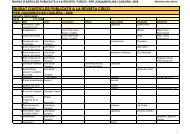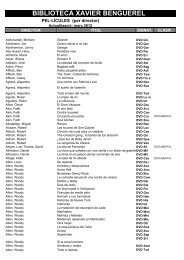38 Egea–Serrano et al.Table 3. Scores for two dimensions extractedby multiple correspondence analysis for<strong>in</strong>dependent variables: E. Eigenvalue. (Forabbreviations see table 2.)Tabla 3. Puntuaciones para las dos dimensionesextraídas por el análisis de correspondenciamúltiple para las variables <strong>in</strong>dependientes. (Paralas abreviaturas ver tabla 2.)Table 4. Scores for amphibian speciesexist<strong>in</strong>g <strong>in</strong> <strong>the</strong> region <strong>of</strong> <strong>Murcia</strong> for <strong>the</strong>variables risk <strong>of</strong> ext<strong>in</strong>ction (RE) and extension<strong>of</strong> distributiion (E).Tabla 4. Puntuaciones de las especies deanfibios presentes en la región de <strong>Murcia</strong>para las variables riesgo de ext<strong>in</strong>ción (RE) yextensión de distribución (E).Dimension 1 Dimension 2Variable (E = 0.63) (E = 0.44)P 0.682 0.911RS 0.369 0.031EN 0.687 0.059HB 0.954 0.939H 0.234 0.229MA 0.308 0.260AE 0.917 0.485AD 0.943 0.937BH 0.770 0.067TU 0.499 0.551Species RE ES. salamandra 3 4A. dickhilleni 3 4A. obstetricans 3 4D. jeanneae 3 5B. calamita 1 2B. bufo 2 3P. punctatus 2 3P. cultripes 2 4R. perezi 1 1salamandra, A. dickhilleni, A. obstetricans and D.jeanneae. However, when <strong>the</strong> IUCN Red ListCriteria are applied to <strong>the</strong>se species at a worldwidelevel (UICN, 2001), only A. dickhhilleni isdescribed as vulnerable (IUCN, 2004). Never<strong>the</strong>less,<strong>the</strong> group formed by <strong>the</strong> above speciesshows a higher risk <strong>of</strong> ext<strong>in</strong>ction than <strong>the</strong> o<strong>the</strong>rstudied species when <strong>the</strong> IUCN Red List Criteriaat country level (UICN, 2003) are applied(Pleguezuelos et al., 2002).The degree <strong>of</strong> agreementbetween this classification and our resultswas good. In relation to <strong>the</strong> rema<strong>in</strong><strong>in</strong>g speciesstudied, although <strong>the</strong>y have not been evaluatedat a worldwide level (IUCN, 2004), when <strong>the</strong>IUCN Red List Criteria are applied at countrylevel (UICN, 2003) <strong>the</strong>y are not classified separately(Pleguezuelos et al., 2002); <strong>the</strong>y all show alow risk <strong>of</strong> ext<strong>in</strong>ction (Least Concern). In contrastwith this classification, <strong>the</strong> <strong>in</strong>dex applied at aregional level <strong>in</strong> <strong>the</strong> present study identified agroup <strong>of</strong> species exposed to a low–medium risk<strong>of</strong> ext<strong>in</strong>ction (B. bufo, P. punctatus and P. cultripes)and ano<strong>the</strong>r group with a low risk <strong>of</strong> ext<strong>in</strong>ction(R. perezi and B. calamita). This difference demonstrates<strong>the</strong> importance <strong>of</strong> a spatial scale <strong>in</strong>evaluat<strong>in</strong>g a taxon´s risk <strong>of</strong> ext<strong>in</strong>ction.If a species <strong>in</strong> a region is considered threatened(as is <strong>the</strong> case <strong>of</strong> S. salamandra, A.dickhilleni, A. obstetricans and D. jeanneae <strong>in</strong><strong>Murcia</strong>) measures must be taken to ensure <strong>the</strong>conservation <strong>of</strong> <strong>the</strong>se populations <strong>in</strong> this territory.Such measures should <strong>in</strong>clude <strong>the</strong> conservation<strong>of</strong> traditional farm<strong>in</strong>g practices because <strong>the</strong>sewould contribute to preserv<strong>in</strong>g terrestrial habitatssuitable for <strong>the</strong> adult <strong>in</strong>dividuals <strong>of</strong> many species,as well as water bodies where many species canf<strong>in</strong>ish <strong>the</strong>ir larval development, as suggested byseveral authors (París et al., 2002; Martínez–Solano et al., 2004; unpublished data).The importance <strong>of</strong> mounta<strong>in</strong> systems <strong>in</strong> amphibianconservation <strong>in</strong> <strong>the</strong> <strong>Region</strong> <strong>of</strong> <strong>Murcia</strong> is clear.Most areas whose conservation has been consideredpriority <strong>in</strong> <strong>the</strong> present study (80%) are located<strong>in</strong> <strong>the</strong> ma<strong>in</strong> mounta<strong>in</strong>s <strong>of</strong> <strong>the</strong> study area, and havebeen proposed as Sites <strong>of</strong> Community Interest(Baraza, 1999). However, only 12% <strong>of</strong> <strong>the</strong> proposedpriority conservation areas are <strong>in</strong>cluded with<strong>in</strong><strong>Region</strong>al Parks (Baraza, 2003), <strong>the</strong> current legallyprotected areas.Mateo (2002) showed some <strong>of</strong> <strong>the</strong>se mounta<strong>in</strong>swere valuable areas for herpet<strong>of</strong>auna conservation,although amphibian and reptile species were consideredtoge<strong>the</strong>r. These areas are characterized byhabitats <strong>of</strong> community <strong>in</strong>terest, such as Tetracl<strong>in</strong>isarticulata, Quercus ilex, Quercus rotundifolia,Juniperus phoenicea, or Juniperus thurifera forests(Baraza, 1999), whose distribution range <strong>in</strong> <strong>the</strong>study area is restricted. Accord<strong>in</strong>g to our results,<strong>the</strong> area show<strong>in</strong>g <strong>the</strong> most noticeable lack <strong>of</strong> protectionis <strong>the</strong> north eastern part <strong>of</strong> <strong>the</strong> study area, aterritory where only three out <strong>of</strong> <strong>the</strong> 12 squaresestablished as priority conservation areas are <strong>in</strong>cluded<strong>in</strong> Sites <strong>of</strong> Communitary Interest or <strong>Region</strong>alParks.
Animal Biodiversity and Conservation 29.1 (2006) 39WHXHYGNWGXGUTM5 x 5 kmFig. 2. Distribution <strong>of</strong> areas <strong>of</strong> <strong>the</strong> highest conservation priority <strong>in</strong> <strong>the</strong> <strong>Region</strong> <strong>of</strong> <strong>Murcia</strong>.Fig. 2. Distribución de las áreas prioritarias de conservación en la Región de <strong>Murcia</strong>.The fact that most priority squares are concentrated<strong>in</strong> <strong>the</strong> northwestern area <strong>of</strong> <strong>the</strong> region, where<strong>the</strong>y co<strong>in</strong>cide with different protected areas, emphasises<strong>the</strong> biological value <strong>of</strong> this territory. Inaddition, <strong>the</strong> value <strong>of</strong> this area <strong>in</strong>creases because<strong>of</strong> its cultural importance from <strong>the</strong> po<strong>in</strong>t <strong>of</strong> view <strong>of</strong>traditional land use conservation (Pérez &Lemeunier, 2003).F<strong>in</strong>ally, it should be mentioned that most <strong>of</strong> <strong>the</strong>priority conservation areas suggested <strong>in</strong> this workare isolated as a consequence <strong>of</strong> <strong>the</strong> severe habitatdestruction that <strong>the</strong> <strong>Region</strong> <strong>of</strong> <strong>Murcia</strong> has undergone,and cont<strong>in</strong>ues to undergo, as a consequence<strong>of</strong> irrigation crop expansion (Martínez & Esteve,2003). Such severe environmental degradation meansthat only species show<strong>in</strong>g low ecological requirements,such as R. perezi, can survive, and it impliesthat most <strong>of</strong> <strong>the</strong> amphibian populations present <strong>in</strong><strong>the</strong> study area will rema<strong>in</strong> isolated. S<strong>in</strong>ce ensur<strong>in</strong>gcolonization and genetic flow from nearby populationsis an essential measure <strong>in</strong> amphibian conservation(Semlitsch, 2002), habitat restoration programmesneed to be undertaken to provide suitable habitatsfor different amphibian species. This would formbiological corridors that make <strong>in</strong>dividual migrationsfeasible. These aspects should be taken <strong>in</strong>to considerationwhen amphibian populations <strong>in</strong> <strong>the</strong> <strong>Region</strong> <strong>of</strong><strong>Murcia</strong> are subjected to management and/or recoveryprogrammes.AcknowledgementsPart <strong>of</strong> this research was supported by <strong>the</strong> EnvironmentalService <strong>of</strong> <strong>the</strong> Autonomous Government<strong>of</strong> <strong>Murcia</strong>, Spa<strong>in</strong>. We thank members <strong>of</strong>Group <strong>of</strong> Investigation Aquatic Vertebrates Conservation<strong>of</strong> <strong>the</strong> Zoology and Physical AnthropologyDepartment <strong>of</strong> <strong>the</strong> University <strong>of</strong> <strong>Murcia</strong> for<strong>the</strong>ir help <strong>in</strong> field sampl<strong>in</strong>g. We also thank PhilipThomas for <strong>the</strong> English translation.ReferencesAlcobendas, M. & Buckley, D., 2002. Salamandrasalamandra. In: Atlas y Libro Rojo de los Anfibiosy Reptiles de España: 55–57 (J. M. Pleguezuelos,R. Márquez & M. Lizana, Eds.). Dirección Generalde Conservación de la Naturaleza, Madrid.Andreone, F. & Luiselli, L., 2000. The Italianbatrach<strong>of</strong>auna and its conservation status: astatistical assessment. Biological Conservation,96: 197–208.Arntzen, J. W. & García–París, M., 1995. Morphologicaland allozyme studies <strong>of</strong> midwife toads(genus Alytes) <strong>in</strong>clud<strong>in</strong>g <strong>the</strong> description <strong>of</strong> twonew taxa from Spa<strong>in</strong>. Contribution to Zoology,65: 5–34.Baraza, F. (Coord.), 1999. Los hábitats comunitarios



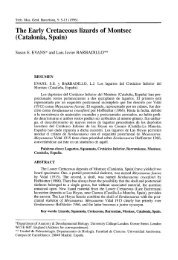
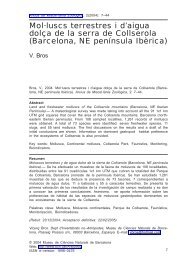
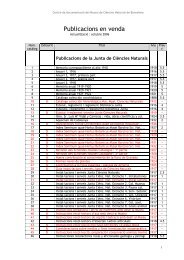
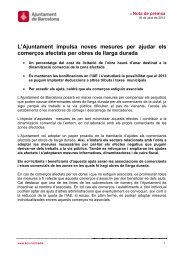
![[ pdf ] José Sanchis Sinisterra](https://img.yumpu.com/14886025/1/190x135/-pdf-jose-sanchis-sinisterra.jpg?quality=85)
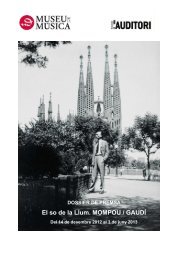
![[ pdf ] II Convenció Les veus de la gent gran 2004 - 2007](https://img.yumpu.com/14629010/1/190x182/-pdf-ii-convencio-les-veus-de-la-gent-gran-2004-2007.jpg?quality=85)

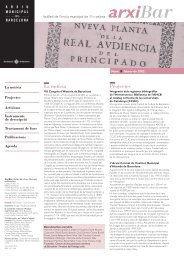

![[ pdf ] Material Escuela Pia Balmes](https://img.yumpu.com/14415004/1/184x260/-pdf-material-escuela-pia-balmes.jpg?quality=85)
